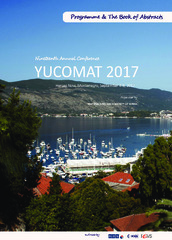Приказ основних података о документу
Corrosion behavior of nanotubular oxide layer formed on titanium and Ti-13Nb-13Zr alloy processed by high pressure torsion
| dc.creator | Barjaktarević, Dragana | |
| dc.creator | Dimić, Ivana | |
| dc.creator | Cvijović-Alagić, Ivana | |
| dc.creator | Đokić, Veljko | |
| dc.creator | Bajat, Jelena | |
| dc.creator | Rakin, Marko | |
| dc.date.accessioned | 2022-11-22T09:01:51Z | |
| dc.date.available | 2022-11-22T09:01:51Z | |
| dc.date.issued | 2017 | |
| dc.identifier.isbn | 9788691911126 | |
| dc.identifier.uri | http://TechnoRep.tmf.bg.ac.rs/handle/123456789/5254 | |
| dc.description.abstract | The good corrosion resistance is crucial for implant biomaterials application, because the metallic ion release from the implant to the surrounding tissue may give rise to biocompatibility problems. In order to optimize and enhance the implant material properties, the implant surfaces can be modified by different chemical surface treatments, including electrochemical anodic oxidation. In the present study nanotubular oxide layer on the surface of ultrafine-grained titanium (UFG cpTi), Ti-13Nb-13Zr (UFG TNZ) alloy and coarse-grained Ti-13Nb-13Zr (CG TNZ) alloy was formed using electrochemical anodization in 1M H3PO4 + 0.5 wt % NaF electrolyte, at room temperature during 60 minutes for UFG cpTi and 90 minutes for investigated alloys. The nanotubes morphology was studied using scanning electron microscopy (SEM). The SEM images showed that anodization of titanium and its alloy in a fluoride-containing electrolyte can lead to the formation of a highly regular self-organized nanotubular layer. Furthermore, nanotubes formed on UFG TNZ alloy were more uniformly arranged compared to nanotubes on CG TNZ alloy surface. The aim of this study was to determine the electrochemical behavior of titanium and its alloy after electrochemical anodization. Electrochemical measurements were performed in artificial saliva with a pH value of 5.5 at 37°C, in order to simulate the oral environment and examine the above-mentioned materials for dental application. The materials were analysed by electrochemical impedance spectroscopy (EIS) and potentiodynamic polarization. All examined materials showed good corrosion resistance. The newly-formed inner barrier and outer porous surface layers were found to be highly resistant with capacitive behavior, but the materials with nanotubular oxide layer on their surface showed improved corrosion resistance. | sr |
| dc.language.iso | en | sr |
| dc.publisher | Materials Research Society of Srebia | sr |
| dc.relation | info:eu-repo/grantAgreement/MESTD/Basic Research (BR or ON)/174004/RS// | sr |
| dc.rights | openAccess | sr |
| dc.rights.uri | https://creativecommons.org/licenses/by/4.0/ | |
| dc.source | Materials Research Society of Srebia | sr |
| dc.title | Corrosion behavior of nanotubular oxide layer formed on titanium and Ti-13Nb-13Zr alloy processed by high pressure torsion | sr |
| dc.type | conferenceObject | sr |
| dc.rights.license | BY | sr |
| dc.citation.spage | 101 | |
| dc.identifier.fulltext | http://TechnoRep.tmf.bg.ac.rs/bitstream/id/13001/bitstream_12994-1-4_merged.pdf | |
| dc.identifier.rcub | https://hdl.handle.net/21.15107/rcub_technorep_5254 | |
| dc.type.version | publishedVersion | sr |

